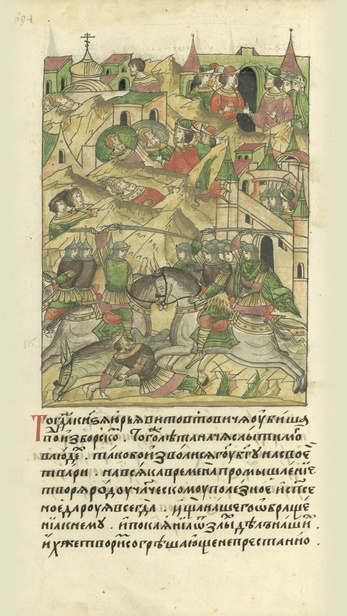Kreuz- und Pilgerfahrt im Ostseeraum als Familientradition: eine Fallstudie zu den Grafen von der Mark (13.–15. Jahrhundert)
 German Crusader knights before the walls of a Russian city. Miniature from the Illustrated Chronicle Manuscript of Tsar Ivan IV, 16th century
German Crusader knights before the walls of a Russian city. Miniature from the Illustrated Chronicle Manuscript of Tsar Ivan IV, 16th century(translated project title)
In 1438, Gerhard von Kleve, Graf zur Mark (1430-1461), wished to go on pilgrimage to the Holy Land. His route led from the County of Mark in today’s North Rhine Westphalia via the Hanseatic cities to Prussia, Livonia and Russia. The trip was well prepared, and Count Gerhard had a letter of recommendation in his pocket from the Grand Master of the Teutonic Order addressed to the Russian earls in Novgorod. On his arrival in Novgorod to his surprise his interpreter Hermann tor Koken was cast into a dungeon in Yamburg in the marshlands of Novgorod and subsequently murdered. The incident led to a severe diplomatic crisis and even to open war (1443-1448) waged by the Teutonic Order and the Livonian cities against Novgorod. The count was forced to turn back having never reached his destination. This so-called “Crisis relating to County Gerhard” is extensively recorded in narrative documents and in correspondence and has accordingly often been the subject of studies. However, why did the count want to travel to Novgorod in the first place if his objective was to get to the Holy Land?
This is the question historian Prof. Aleksey Martyniouk asks, and he assumes that the roots of the unusual route taken by Count Gerhard are to be found in the tradition of an enduring “interest Eastwards” by the von Mark family. To be precise: in the repeated participation of the men in County Mark in crusades against the “Lithuanian heathens and Russian schismatics” in the Baltic region between the 13th and 15th centuries. Count Gerhard’s uncle Engelbert III von der Mark (1346-1391) had already embarked on one of the crusades in Prussia and Livonia, where amongst other things he participated in the 1381 siege of the “Heathen city of Plosko” (Polozk in what is today Belarus). A century earlier, Count Engelbert I had been one of the knights in a crusade in Prussia and in 1330 a Count von Mark whose name is not known took part in the war by the Teutonic Order against Lithuania. Despite these bellicose interventions, there is evidence of both Gerhard and Engelbert III having undertaken spiritual pilgrimages to eastern Europe.
In his search for an extraordinary family tradition, Prof. Martyniouk has been reassessing the international source material – from Lower Rhine and Hanseatic chronicles through to eastern Slavic documents – and in the process combining Western and Eastern research. While modern German historical research tends to concentrate on social and cultural history, from the east European perspective the family traditions of von Mark counts taking part in crusades and pilgrimages to the ostensibly “Wild East” is clear. Conversely, the studies of Western sources first enable the travels of the individual representatives of the aristocratic families, the nameless crusaders, to be identified – those who otherwise crop up “out of nowhere” in the reports contained in the East Slavic chronicles.
In this way, Professor Martyniouk’s research places actual people in the Middle Ages centre stage in order on the basis of individual case studies to then trace the close international relations in the 13th to 15th centuries over and beyond any national historiographies. He intends to publish his findings in the form of contributions to specialist conferences and as a monograph.
Grant holder
Prof. Dr. Aleksey Martyniouk, Minsk (Belarus)
Support
The Gerda Henkel Foundation supports the project by granting a scholarship and covering the costs of travel and materials.
This project was documented in spring 2023.

